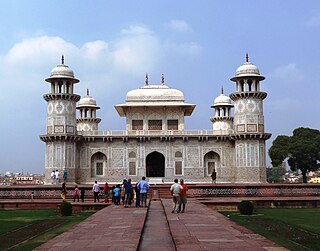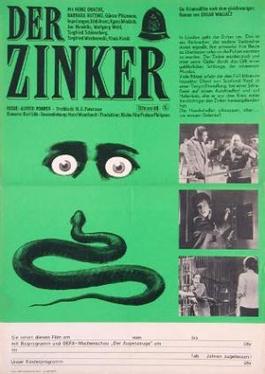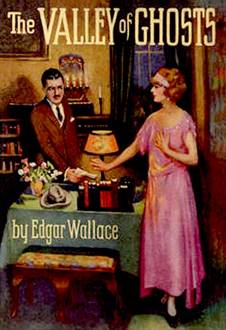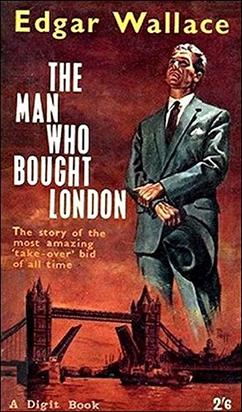
A tomb is a repository for the remains of the dead. It is generally any structurally enclosed interment space or burial chamber, of varying sizes. Placing a corpse into a tomb can be called immurement, although this word mainly means entombing people alive, and is a method of final disposition, as an alternative to cremation or burial.

"Annabel Lee" is the last complete poem composed by American author Edgar Allan Poe. Like many of Poe's poems, it explores the theme of the death of a beautiful woman. The narrator, who fell in love with Annabel Lee when they were young, has a love for her so strong that even angels are envious. He retains his love for her after her death. There has been debate over who, if anyone, was the inspiration for "Annabel Lee". Though many women have been suggested, Poe's wife Virginia Eliza Clemm Poe is one of the more credible candidates. Written in 1849, it was not published until shortly after Poe's death that same year.

The Liang dynasty, alternatively known as the Southern Liang in historiography, was an imperial dynasty of China and the third of the four Southern dynasties during the Northern and Southern dynasties period. It was preceded by the Southern Qi dynasty and succeeded by the Chen dynasty. The rump state of Western Liang existed until it was conquered in 587 by the Sui dynasty.

Richard Horatio Edgar Wallace was a British writer.

The Ming tombs are a collection of mausoleums built by the emperors of the Ming dynasty of China. The first Ming emperor's tomb is located near his capital Nanjing. However, the majority of the Ming tombs are located in a cluster near Beijing and collectively known as the Thirteen Tombs of the Ming dynasty. They are located within the suburban Changping District of Beijing Municipality, 42 kilometers (26 mi) north-northwest of Beijing's city center. The site, on the southern slope of Tianshou Mountain, was chosen based on the principles of feng shui by the third Ming emperor, the Yongle Emperor. After the construction of the Imperial Palace in 1420, the Yongle Emperor selected his burial site and created his own mausoleum. The subsequent emperors placed their tombs in the same valley.

Marginalia are marks made in the margins of a book or other document. They may be scribbles, comments, glosses (annotations), critiques, doodles, drolleries, or illuminations.

The Mummy: Tomb of the Dragon Emperor is a 2008 American action adventure fantasy film directed by Rob Cohen, written by Alfred Gough and Miles Millar, and produced by Stephen Sommers, Bob Ducsay, Sean Daniel, and James Jacks. The film is set in China rather than Egypt and focuses on the Terracotta Army's origins. It is the third and final installment in The Mummy trilogy. It stars Brendan Fraser, Jet Li, Maria Bello, John Hannah, Luke Ford, Anthony Wong, and Michelle Yeoh.

Naqsh-e Rostam is an ancient archeological site and necropolis located about 12 km northwest of Persepolis, in Fars Province, Iran. A collection of ancient Iranian rock reliefs are cut into the face of the mountain and the mountain contains the final resting place of four Achaemenid kings, notably king Darius the Great and his son, Xerxes. This site is of great significance to the history of Iran and to Iranians, as it contains various archeological sites carved into the rock wall through time for more than a millennium from the Elamites and Achaemenids to Sassanians. It lies a few hundred meters from Naqsh-e Rajab, with a further four Sassanid rock reliefs, three celebrating kings and one a high priest.

The term Chinese pyramids refers to pyramidal shaped structures in China, most of which are ancient mausoleums and burial mounds built to house the remains of several early emperors of China and their imperial relatives. About 38 of them are located around 25 kilometres (16 mi) – 35 kilometres (22 mi) north-west of Xi'an, on the Guanzhong Plains in Shaanxi Province. The most famous is the Mausoleum of the First Qin Emperor, northeast of Xi'an and 1.7 km west of where the Terracotta Army was found.

The Eastern Qing tombs are an imperial mausoleum complex of the Qing dynasty located in Zunhua, 125 kilometres (78 mi) northeast of Beijing. They are the largest, most complete, and best preserved extant mausoleum complex in China. Altogether, five emperors, 15 empresses, 136 imperial concubines, three princes, and two princesses of the Qing dynasty are buried here. Surrounded by Changrui Mountain, Jinxing Mountain, Huanghua Mountain, and Yingfei Daoyang Mountain, the tomb complex stretches over a total area of 80 square kilometres (31 sq mi).

The Squeaker is a 1963 West German-French crime film directed by Alfred Vohrer and starring Heinz Drache. It was part of a very successful series of German films based on the writings of Edgar Wallace and adapted from the 1927 novel of the same name.

The Four Just Men is a detective thriller published in 1905 by the British writer Edgar Wallace. The eponymous "Just Men" appear in several sequels.

The Ringer is a 1931 British crime film directed by Walter Forde and starring Patric Curwen, Esmond Knight, John Longden and Carol Goodner. Scotland Yard detectives hunt for a dangerous criminal who has recently returned to England. The film was based on the 1925 Edgar Wallace story The Gaunt Stranger, which is the basis for his play The Ringer. Forde remade the same story in 1938 as The Gaunt Stranger. There was also a silent film of The Ringer in 1928, and a 1952 version starring Donald Wolfit.

Shou Qiu is a historical site on the eastern outskirts of the city of Qufu in Shandong Province, China. According to the legend, Shou Qiu is the birthplace of the Yellow Emperor.

The Valley of Ghosts is a crime novel by the British writer Edgar Wallace which was first published in 1922.
Bryan Edgar Wallace (1904–1971) was a British writer. The son of the writer Edgar Wallace, Bryan was also a writer of crime and mystery novels which were very similar in style to those of his father. He was named after the American politician William Jennings Bryan who his father encountered during a trip to North America.

The Man Who Bought London is a 1915 crime novel by the British writer Edgar Wallace. It was originally published as a magazine serialisation.
An African Millionaire is a 1904 play by the British writer Edgar Wallace, then a journalist working for the Daily Mail.

Those Folk of Bulboro is a 1918 novel by the British writer Edgar Wallace. It is likely it was written before the First World War, possibly even as early as 1908, and that Wallace produced the old manuscript to fulfil his contract with his publishers Ward Lock.

The Daffodil Mystery is a 1920 thriller novel by the British writer Edgar Wallace. It features the detective Jack Tarling and his Chinese assistant Ling Chu.

















